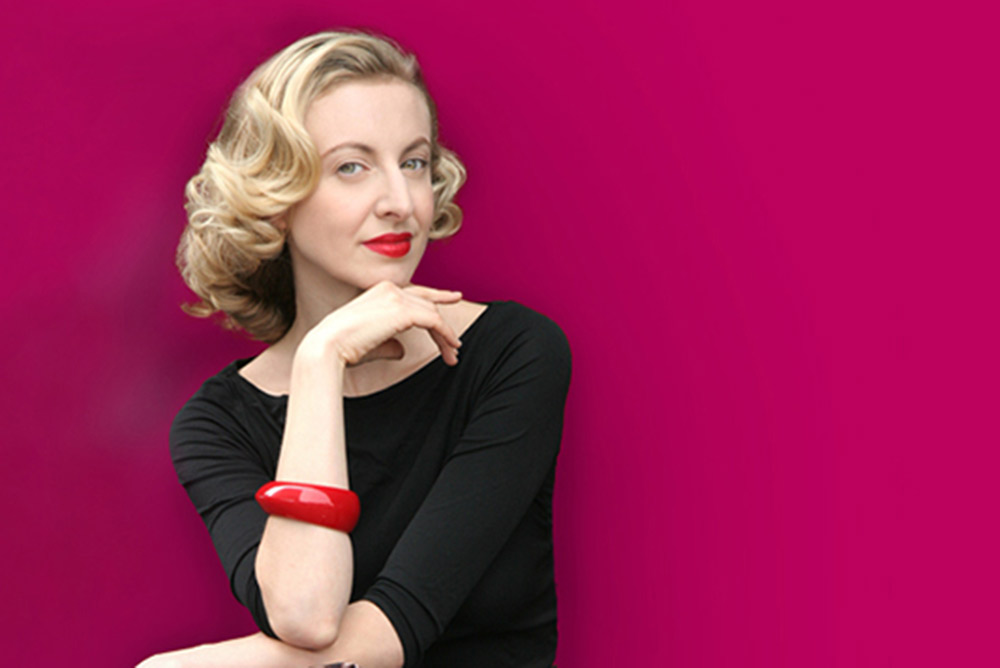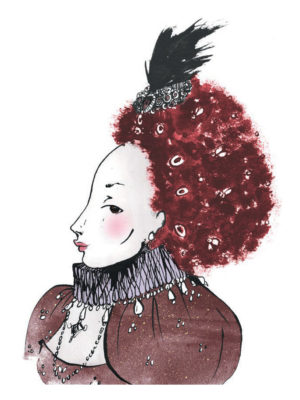
Poppy King
Poppy King, entrepreneur and founder of cosmetics brand Lipstick Queen, has been a devotee of lipstick and its transformative powers ever since she was a child trying on her mother’s slick stick of burgundy from Biba. In her new pocket-size book, The A to Z of Lipstick, King advises readers on everything from color choices and application tricks to how lipstick is made. In the excerpt below, King paints the history of lipstick with its colorful characters, including Cleopatra and Queen Elizabeth I. The A to Z of Lipstick can be purchased at local bookstores as well as at Amazon and Barnes & Noble.
THE ART OF PAINTING the lips dates all the way back to ancient times where it was done as part of rituals and to honor the gods. Lipstick first appeared as a symbol of glamour in Egypt with Cleopatra, who became famous not just for her dark kohl eye makeup but for her ruby-red lips painted with rouge made with carmine (a pigment derived from an insect called the cochineal). Carmine is used in lipstick to this day.
It became very aspirational to paint the lips red, but with the fall of the Egyptian empire and the rise of the Dark and Middle Ages in Europe, the Catholic Church took over as the ultimate dictator of acceptable fashion and grooming practices. Lip color was associated with Satan and therefore relegated to the very bottom of the social ladder.

There it remained until the late sixteenth century, when Queen Elizabeth I brought it back into vogue, with her stark white makeup and crimson lip stain made from beeswax and red plants. Like Cleopatra before her, Elizabeth elevated lip coloring, and soon many high-class women sought to imitate her style.
After Elizabeth’s death, lipstick slipped from fashion, and until the late nineteenth century lip coloring remained a practice reserved for performers and prostitutes.
But by the end of the nineteenth century, the rise of industrialization had allowed lipstick to be mass-produced, and its usage started to spread again. In 1884 the French cosmetic company Guerlain created the first commercial lipstick. They made it from deer tallow, castor oil, and beeswax, and then covered it in silk paper. Lipstick did not yet come in a tube, but came in small pots, and was applied with a fine brush.
Around this time, famous French actress Sarah Bernhardt began wearing lipstick
in public—and by 1912, fashionable American women were using lipstick as an important part of their daily beauty regimen. In 1915 Maurice Levy invented the cylindrical metal containers that hold lipstick today, but it wasn’t until 1923 that the swivel-up tube was patented by James Bruce Mason Jr. in Nashville, making lipstick much easier to apply.
The 1920s saw a rise in photography and cinema, which made movie stars fashion icons—and their lipstick was sought after. In the 1930s the cosmetics company Max Factor capitalized on the growing mystique around film stars and started replicating the products that were worn onscreen, including lipsticks.
During World War II, lipstick became scarce due to rationing, yet wearing it was also considered patriotic, as it denoted optimism and strength in a time of hardship.
This was thanks to Rosie the Riveter, the famous depiction of a female factory worker with red lips doing the work that was needed while men were away at war. She became a symbol of carrying on in good faith.
By the 1950s, movie star glamour was in full effect, with stars such as Marilyn Monroe and Elizabeth Taylor sporting dark red lips and popularizing them for the masses.
With the 1960s and the rise of rock and roll came dramatic new ideas in fashion, as well as lipstick. Anything went—from pastel shades to white and silver. By the late ’60s and ’70s, however, lipstick had lost some popularity, as the hippie trend took over, and a more natural look came into favor.
Lipstick returned with a vengeance in the 1980s with the rise of the power woman and her bulletproof shoulder pads. Lip colors were bright and garish—mostly hot pink and fuchsia. The 1990s and the emerging grunge trends saw a backlash to this, with browns and deep hues coming into fashion.
By the early 2000s, lipstick had taken a back seat to lip gloss, which was considered a fuss-free alternative. These days, however, we are seeing a renewed interest in lipstick—not as a makeup “must-have” but as a personal fashion choice. Major cosmetics houses are revamping their lines, releasing new lipstick formulas, which contain varied ingredients and allow for a vast array of finishes.
Lipstick remains one of the world’s simplest and most glamorous products. And its application is one of the few grooming rituals that connect us back through centuries to the experience of being female. In any given age, lipstick—its presence or absence—tells us something about the world we are living in and the hopes and dreams of the era. It is a true cultural barometer—one that measures not just the state of fashion but that of the psyche.
Excerpted from The A to Z of Lipstick by Poppy King. The book was published last week by Atria Books, a division of Simon & Schuster.
